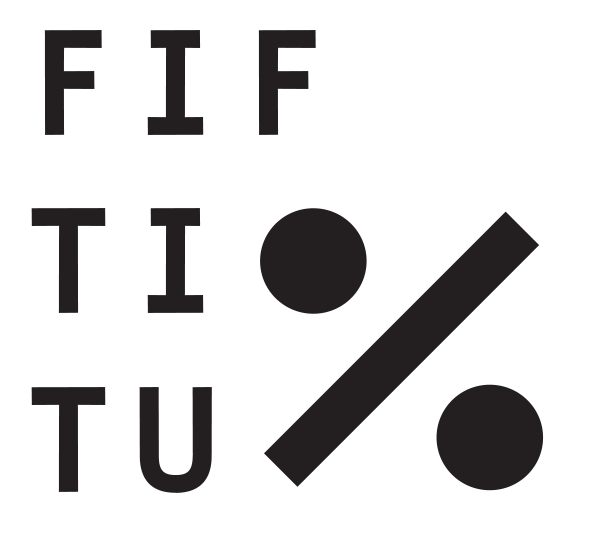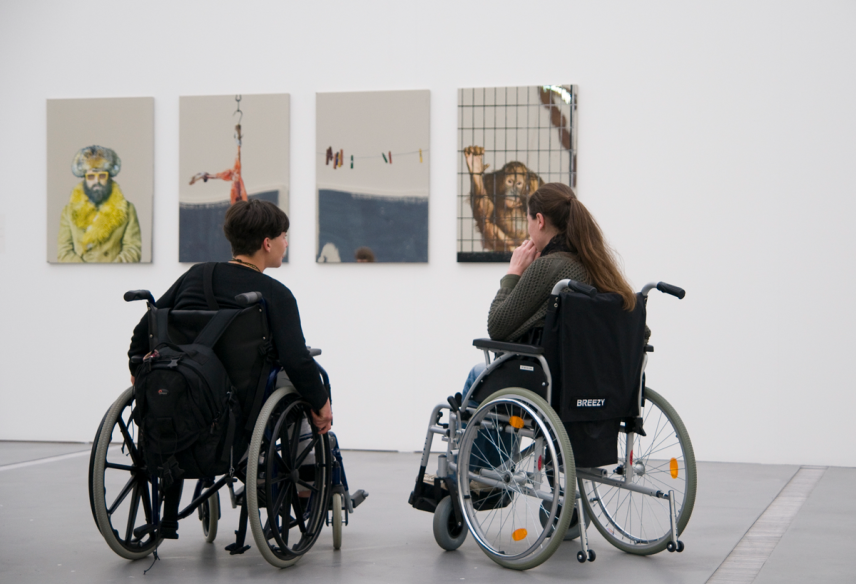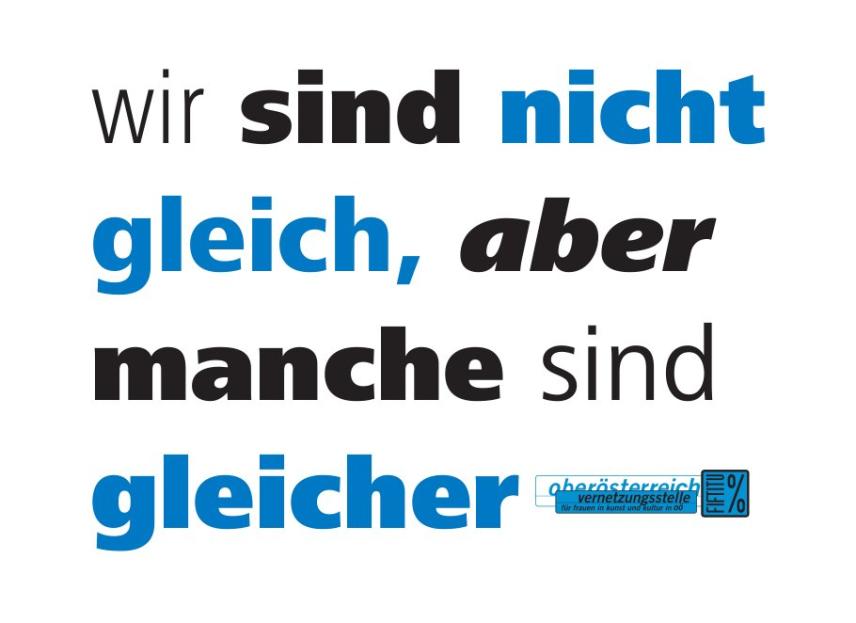"We are not all the same, but some are more equal"
In 2011, FIFTITU% - Networking Center for Women in Art and Culture in Upper Austria set itself the goal of exploring the topic of equality in various political and practical contexts under the motto "We are not all equal, but some are more equal". Three events kicked off the project in spring: An intervention in a museum, a philosophical lecture and a workshop on equality goals in the field of art and cultural work. A subjective review of what has happened so far ...
Parallax in the museum
I am just one of many, but I was lucky enough to be asked by FIFTITU% to report on the first events. I make my way to the Lentos Art Museum, where the first intervention on the topic of equality, or more precisely: accessibility, is to take place. I wonder who is taking part and who the target group might be? Women from the local art and culture scene? Those who are critical and sensitive about the topic anyway? Or is this a misjudgement, megalomania, a benevolent prejudice? With these thoughts in mind, I approach the Lentos Art Museum and see the usual suspicious women there. Only a few accepted the first invitation, yet FIFTITU% critically and humorously dissects, deconstructs and reformulates difficult topics. But chewing over, twisting and turning a socio-political focal point is and remains work. Thinking can hurt. Leaving your ideologies behind can be frightening. Questioning your position can be unpleasant. And yet women* and men* do it because women* and men* follow the ideal of an open society in which free access to resources, media, public spaces and architecture is possible. And this does not mean the romantic idea of the blind coachwoman who wants to lead the horse into a just world, but is a political vision... The wheelchairs are neatly lined up in front of the Lentos. In this place, it looks like a work of art. But they are for us, for our self-test. If women* and men* want to find out what life with a wheelchair means, they can take the self-test. No sooner said than done. The participants in the Rediabled editorial team show us how, and we do the same. Rolling up in the museum. The Lentos building is something of a showcase project as far as accessibility is concerned. Nevertheless, it soon becomes clear what living with a disability can mean. Waiting in front of the elevator, there are almost a dozen of us in wheelchairs, which can take a while. The museum guards are very friendly. Really, very. And where women* and men* usually glide elegantly past on two legs, the wheelchair suddenly feels cramped. Suddenly the exhibition architecture seems somehow precarious. It is the seemingly small details that people who move around the space without a wheelchair would never notice, but which are frustrating for people with disabilities. The self-test leads to a certain sensitization, women* and men* ask questions in the room. Are there hall texts in Braille? Are impaired people denied access to museum art and why? FIFTITU% involves the art educator in a discussion about accessibility in the museum. There are interventions on the part of the museum to realize equality, but the target group settles at a low level. Following the cost-benefit calculation, the special adaptations in the room remain manageable. In addition, the communication structure at Lentos is hierarchical. Demands should be brought to the building from outside, emphasizes the mediator. However, Lentos offers a largely barrier-free environment, such as audio guides and a wheelchair if required. After the Arte Povera exhibition, there is a certainty that it is only through dialogue that the problem of marginalization will enter the general consciousness. Much remains to be done by institutions and associations. Not everything revolves around architecture. Accessibility also includes the complex of communication and information, access to the Internet, which is linked to assistive technologies. General information on accessibility can be obtained from the Federal Social Welfare Office, more precisely from ÖAR - Austrian Working Group for Rehabilitation and the nine regional offices. Women* and men* can also obtain unbureaucratic information from the "Freiraum Europa" association
Theory - Criticism - Utopia
After the practice and the self-test as part of the intervention "Aufrollen", FIFTITU% wants to discuss the theoretical aspects of equality. Political theory can be tricky. Philosophy, by its reputation, is the more precise approach. The lecture evening will open in the HOSI event hall. Philosopher Birge Krondorfer will talk about equality goals and practices. The setting: Three women in black have gathered in front of the black curtain to lead us through the evening. Simone Boria, board member of FIFTITU%, moderates the intro to the philosophical lecture in black vinyl pants. Birge Krondorfer, the thinker, wears washed-out black, her glasses are low-set, always ready for the text. At her side, the sign language speaker, also in black. After the moderation, Krondorfer opens her lecture with doubt. She talks about the difficulty of approaching the concept of equality. Welcome to the realm of philosophy. This is about substance, about the bones of word, context and meaning.
On the one hand, Krondorfer opens up several ways in which women* and men* can approach the topic, while on the other, she disputes much of what is often hastily handed down in so-called common sense. When women* and men* question what is taken for granted, concepts sometimes begin to wobble. The term gender mainstreaming is no different. Krondorfer breaks down the word gender mainstreaming and shows its limits in the German language, rephrased as gender mainstreaming policy. The problem of simplifying a complex issue is made clear. Equality? Krondorfer asks: Who puts whom where? The matter is not so simple that a theory of justice - if it were only one! - theory of justice could simply be implemented in everyday life. When women* and men* think about equality, the problem arises that heterogeneous lifestyles and social positions exist. Krondorfer opens up ways in which the topic of equality can be addressed. For example, through legal frameworks: these should ensure that access to money, time and freedom is legally protected. It still works badly. The old demand of "equal pay for equal work" is usually only discussed by the general public on International Women's Day. What remains is a feeling of unease. The unease is an individual's feeling that results from the fact that the individual is partially at the mercy of the effects of inequality through and in social constructions. Powerlessness. This is where politics must be considered and reanimated in the context of the polis. In democracy, women* and men* have agreed to negotiate what they have in common. But are equal treatment and equality concepts that mean the same thing? Can and should women* and men* treat people with different starting conditions equally and, above all, how? It turns out that there is a dilemma in the equalization of differences. A culture of consensus, as formulated in the political theory of post-democracy, is not always the best guide. A culture of conflict, in the sense of the constant renegotiation of common but also individual positions, is exhausting but necessary. In real terms, this means an overwhelming complexity that seems intricate like a labyrinth. Moreover: Sisyphus sends his regards. Self-correction and renegotiation in perpetual motion. The drive for this feat of strength is found in utopia. This utopia is not a cobbled-together fantasy land, but a socio-political, non-violent, anarchist ideal that women* and men* might learn to live up to through theory and criticism.
The lecture was a good opportunity for self/reflection, also in the group - women* and men* can show each other their blind spots. Equality policy, the term doesn't rock. But dealing with it also allows small collectives and associations to make one or two long-needed course corrections.
Nobody is perfect.
Invisible pitfalls
Araba Evelyn Johnston-Arthur held a workshop at the HOSI entitled "Equality goals as an anti-discriminatory tool in art and cultural work". Here too: Terminology. What is racism? What is nationalism? Where are the boundaries? And what is resentment? What legacy and what new inequalities do we convey in everyday language? Prejudice, language, culture. How does discrimination work structurally? How does power work and what constitutes power? And why does it often remain hidden in its many manifestations in everyday life, even to the most critical mind? Structural violence refers to a concept that has comprehensively expanded the classic concept of violence and was formulated as early as 1969 by the Norwegian peace researcher Johan Galtung. Structural violence and sins of omission. What is denied to an individual and why? Where does discrimination begin and where does exploitation start? As different as lifeworlds are, there are some guidelines for action that can be used to take a closer look at conditions and structures. These are the basic dimensions of age, gender, labor force, place of residence, ethnicity, etc. Mechanisms of inclusion and exclusion occur via these "characteristics". Social sorting. The hierarchical structures and power imbalances in society do the rest. The answer: form countercultures. Grassroots movements, as Galtung put it, describe the so-called voices from below. In the field of media, women* and men* speak of free media and open access. The community formulates its own issues. The range is wide. The uniform society is an illusion. Ethnic communities. News from below through homeless newspapers. Radio editorial offices of people with disabilities. Centers by and for migrants. Examples of associations and collectives that have formed out of the need to make their own agendas an issue. Marginalized, inadvertently, out of disinterest or ignorance. Those who are ignored must speak for themselves. Their own creative power. Power is positive when the pitfalls are known. The list of possibilities for creative interventions and intelligent refusal strategies is long. These are methods that enable access, resources and equal treatment, in which possibilities and action potentials are explored and tried out. Build ramps, seek dialog, refuse to use the N-word and break what breaks you. Nobody wants to promote structural violence or fall into the role of complicity. No one wants to fall for the fallacy of having to hire a quota migrant for their own cultural association. Honesty. Knowledge. Knowing the exclusivity of your own milieu. That's a good start to putting a stop to the bad.
One of many
Photo: Petra Moser
Lentos Art Museum: Michelangelo Pistoletto_Courtesy Kunstsammlung Liechtenstein Vaduz_VBK


